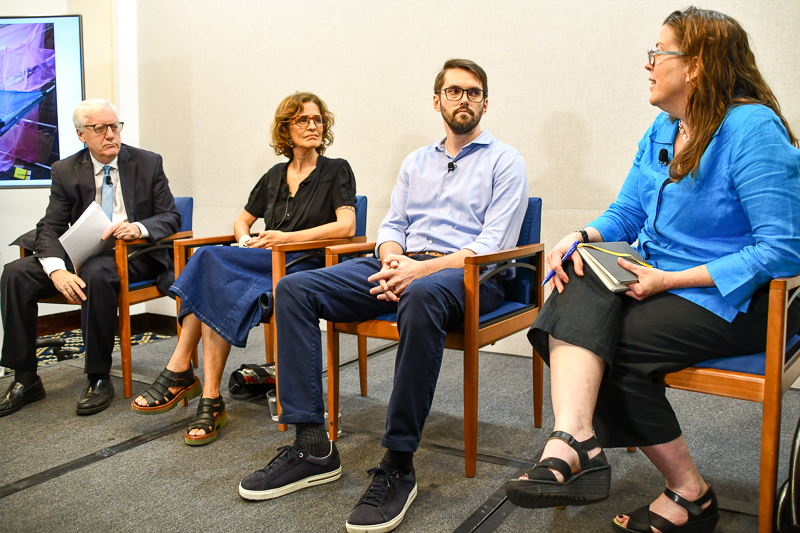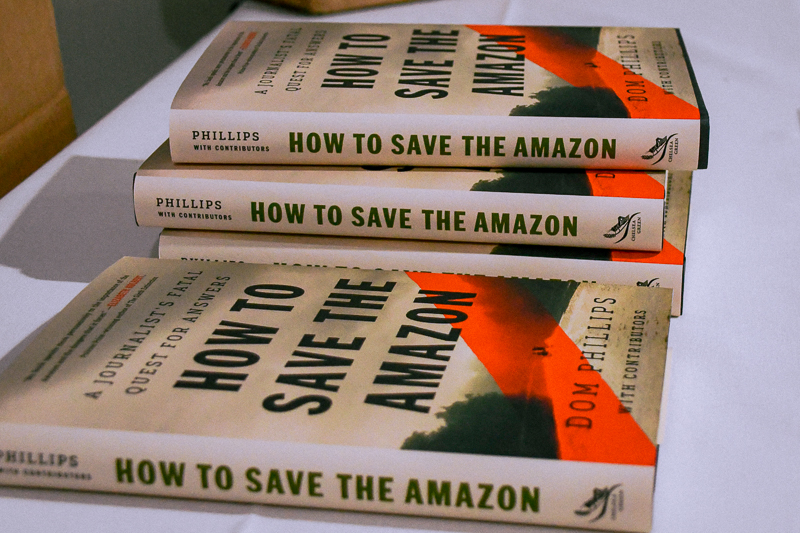Journalists at Press Freedom Center event sound alarm on Amazon's Future
Three journalists gathered at the National Press Club on Wednesday to discuss the urgent threats facing the Amazon rainforest, highlighting the legacy and work of Dom Phillips, the British reporter killed in 2021 while investigating illegal mining and deforestation in Brazil.

The event featuring Phillip’s book, How to Save the Amazon: A Journalist’s Fatal Quest for Answers, was hosted by Bill McCarran, the director of the Club’s Press Freedom Center. The panel featured The Intercept investigative journalist Andrew Fishman, New York Times global health reporter Stephanie Nolan, and independent journalist Alessandro Sentaio, who reflected on Phillips’ work and examined the environmental, political, and human rights crises at the heart of his reporting.

Amazon Nearing Dangerous Tipping Point
Phillips dedicated his career to covering the Amazon, exposing deforestation and its global consequences. Panelists emphasized how ongoing environmental destruction could push the rainforest past an ecological tipping point, potentially transforming vast swaths into savannah or desert.
“The perils of the Amazon that Dom was writing about are far from over,” Nolan said. “The problems he described remain, and they are monumental.”
Phillips sought to elevate indigenous perspectives in conservation, stressing that effective solutions must originate from those who call the rainforest home.
“We tend to think about the Amazon as trees, maybe as an ecosystem, but not as people,” Nolan said. “More humans live in the Amazon than live in Canada. The pressures on the rainforest come from those people, and the solutions start with them.”
The event featured Dom Phillip’s book, "How to Save the Amazon: A Journalist’s Fatal Quest for Answers." Phillips was killed in 2021 while investigating illegal mining and deforestation in Brazil.
Politics and Profit Driving Deforestation
Fishman pointed to economic and political forces fueling Amazon destruction, explaining that global banks, agribusiness giants, and government subsidies overwhelmingly favor industries that drive deforestation.
“The amount of profit derived from these industries is minuscule in the grand sense of the global economy. Yet the damage they cause is permanent,” Fishman said. “The biggest barrier to saving the Amazon isn’t lack of solutions, it’s politics, profit, and control.”
Brazil has struggled to curb deforestation, particularly under former President Jair Bolsonaro whose administration weakened environmental protections. Though deforestation rates have declined under President Luiz Inácio Lula da Silva, panelists warned that systemic issues remain.
The Dangers of Covering the Amazon
Phillips and Brazilian researcher Bruno Pereira were murdered in 2021 while reporting on illegal mining. Their deaths revealed the increasing dangers journalists face when investigating environmental crime.
“Dom was killed for trying to tell a story,” Sentaio said. “And that is fundamentally outrageous.”
Reporters covering Amazon deforestation frequently face lawsuits, threats, and violence. Panelists noted that powerful industries and corrupt officials use legal harassment — known as “lawfare” — to suppress investigations. Despite these challenges, Phillips remained hopeful.
“Journalists are sometimes cynical, but Dom wasn’t,” Fishman said. “He was realistic, but optimistic. He believed saving the Amazon was possible — otherwise, he wouldn’t have done this work.”
A Call to Action
The panelists stressed that protecting the Amazon demands global responsibility. International corporations and financial institutions must implement sustainable practices and stop funding harmful industries.
Research indicates that shifting the Amazon to a sustainable economy may require $520 billion in funding over the next two decades. Panelists called on governments to focus on conservation rather than immediate financial gain and to enhance protections for journalists and environmental advocates.
“There [is] hope in the fact that people rallied around Dom’s work,” Sentaio said. “Since the day he went missing, a community of people came together to ensure his story was told and that mission continues.”
As the discussion wrapped up, panelists reinforced Phillips’ core message: the Amazon is not just trees — it’s people. “If we start by recognizing that, we might stand a chance of saving it,” Nolan said.
Phillips’ legacy, they agreed, is carried forward by those continuing the fight to protect the rainforest.
